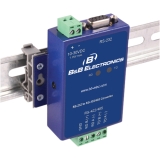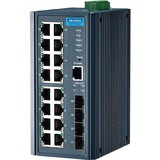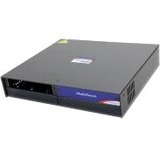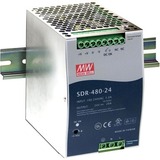
Interface Modules 9P 232 2 WIRE 1 PS RS-232 2000V Isolat
OPTICAL RS-232 ISOLATORS TO SUIT ALMOST ANY APPLICATION
Our RS-232 optical isolators are ideally suited for many applications - from "control panel" installations requiring DIN Rail mounting to "in-line" or "bump in the cable" installations found in laboratory or retail systems. They provide 2 kV of isolation to protect your equipment as well as a variety of connector options. If you require extended temperature ranges and extra rugged construction, our industrial products will fit the bill. They have advanced EMC and emissions specifications that run the gamut from light industrial EN 61000-6-1 to heavy industrial EN 61000-6-2 with IEEE 1613. We also offer versions with UL 508 and UL Class 1 Division 2. Check out the specs on each product and select the optical isolator that is best suited for your needs.

RS-232 to RS-422/485 Converter, Panel Mount, Iso
Our SCP series RS-232 to RS-422/485 serial converters are compact and tough. Each model is designed and tested to meet heavy industrial EMC standards. The RS-232 signal is connected through a female DB9 connector. The RS-422/485 (2-Wire and 4- Wire) signal is connected through a removable terminal block, making wiring easy. Power is connected through a two position removable terminal block. Our bit-wise enabled circuitry automatically detects the character time-out eliminating the need to set DIP Switches for the baud rate.

RADIO MODEM START KIT 2RADIOS 2.4G 2POWER SUPPLIES 2CABLES CD

B&B 3.8/5/5 DBI Dual Band 2.4/5 Ghz Antenna, Rubber Duck RP-SMA

16CH ISOLATED DI ETHERNET/IP MODULE
Advantech Industrial EtherNet/IP Remote I/O modules
Advantech's ADAM-6100 series is a new line of Isolated Industrial Ethernet Remote I/O modules. Equipped with the EtherNet/IP protocol, ADAM-6100EI series also allows daisy chain connections, making it possible to transfer data much faster during process control and other industrial automation applications.
Compatible with AllenBradley controllers.

4CH RELAY OUTPUT MODBUS TCP
In order to fulfill ideal remote DAQ devices in IoT world, Advantech releases ADAM-6200 series, a new selection of Ethernet I/O family comprised of analog I/O, digital I/O and relay modules. ADAM-6200 series module possesses plenty of advanced features whatever the evolution of hardware design and what's worth expecting for user is a variety of useful software functions to make it effective in the application field. With new design and strong capabilities, ADAM-6200 can be a well-integrated I/O solution in Ethernet control system.

16G+4SFP PORT MANAGED ETHERNET SWITCH WIDE TEMPNEMA TS2EN50121-4

IE-SFP/1250-ED SSLX-SM 1550-SC 1550T/1310R
Advantech's SFPs provide robust industrial performance with an extended operating temperature range. Through real-time monitoring, the DDM (digital diagnostic monitoring) functionality provides users critical information such as receive optical power, transmitted optical power, laser bias current, input voltage, and temperature in the network. This approach enables better fault isolation and error detection.

INTEL ZEON CPU XEON 2.1G 28M 3647P 20C GOLD 6230

GIGA-MCBASIC-II TX/LX-SM1310/PL 856-30604
The IMC-450 and 470 support troubleshooting features such as LinkLoss and Fiber Alert which can be enabled/disabled by DIP switches. The diagnostic features allow the network administrator to quickly identify network faults. The IMC-470 series provides two 10/100/1000Mbps copper UTP ports and one fiber port, that is available in an SFP form factor, as well as for fixed-fiber in single-mode and multi-mode. The Link Fault Pass Through (LFPT) functionality allows network operators to determine a fault condition on the interface.

IMEDIACHASSIS/3-DC 850-10949-DC
The IMC-713/716/719 series has the highest port density in the industry -- along with a robust design, hot-swappable architecture, SNMP management via iView , and redundant power supplies for fault tolerance, which a diverse range of applications, using a variety of protocols, require. The temperature controlled fans in the IMC-713/716 chassis activate only when the chassis reaches a certain temperature, thereby extending the life of the fans. The fans on the IMC-719 series can be remotely controlled via SNMP.

IE-IMCV-T1/E1/J1-LINETERM TP/FI 850-18103
The IMC-721I-T1MUX and IMC-721I-E1MUX are double wide media converters for the IMC-71x chassis series that transports four independent T1 lines over a single or dual fiber optic line. They support a full bandwidth 10/100BaseT Ethernet connection over the same optical link. The fiber redundancy (1+1) functionality on removable SFP modules offers the enhanced reliability of a protected fiber link while supporting the complete range of optical types and distances. They also feature an independent serial link (RS-232) which is useful for local monitoring and configuration of the unit by technical support personnel.
The IMC-723 series enables users to convert coaxial media to single-mode fiber and extend the distance of data transmissions over access networks up to 40km. The series supports premise networking applications to convert the incoming circuit to fiber for distribution into the structured cabling system.
The IMC-720 series are installed as a host-remote pair and can be remotely managed when the host is installed in an IMC-713/716/719 series with an SNMP management module. Since IMC-700 media converter series management technology functions transparently to the user data, real-time and end-to-end management is provided at all times.

IEIMCVT1/E1/J1LINETERM TP/SSFIB 850-18124
The IMC-721I-T1MUX and IMC-721I-E1MUX are double wide media converters for the IMC-71x chassis series that transports four independent T1 lines over a single or dual fiber optic line. They support a full bandwidth 10/100BaseT Ethernet connection over the same optical link. The fiber redundancy (1+1) functionality on removable SFP modules offers the enhanced reliability of a protected fiber link while supporting the complete range of optical types and distances. They also feature an independent serial link (RS-232) which is useful for local monitoring and configuration of the unit by technical support personnel.
The IMC-723 series enables users to convert coaxial media to single-mode fiber and extend the distance of data transmissions over access networks up to 40km. The series supports premise networking applications to convert the incoming circuit to fiber for distribution into the structured cabling system.
The IMC-720 series are installed as a host-remote pair and can be remotely managed when the host is installed in an IMC-713/716/719 series with an SNMP management module. Since IMC-700 media converter series management technology functions transparently to the user data, real-time and end-to-end management is provided at all times.

IE-IMCV-T1-MUX/4+ETHERNET SFP R 857-18110
The IMC-721I-T1MUX and IMC-721I-E1MUX are double wide media converters for the IMC-71x chassis series that transports four independent T1 lines over a single or dual fiber optic line. They support a full bandwidth 10/100BaseT Ethernet connection over the same optical link. The fiber redundancy (1+1) functionality on removable SFP modules offers the enhanced reliability of a protected fiber link while supporting the complete range of optical types and distances. They also feature an independent serial link (RS-232) which is useful for local monitoring and configuration of the unit by technical support personnel.
The IMC-723 series enables users to convert coaxial media to single-mode fiber and extend the distance of data transmissions over access networks up to 40km. The series supports premise networking applications to convert the incoming circuit to fiber for distribution into the structured cabling system.
The IMC-720 series are installed as a host-remote pair and can be remotely managed when the host is installed in an IMC-713/716/719 series with an SNMP management module. Since IMC-700 media converter series management technology functions transparently to the user data, real-time and end-to-end management is provided at all times.

IE-IMCV 2XLIM 100MBPS 2 RJ45 850-18610
The IMC-750/751 series are slide-in module Ethernet-to-fiber media converters for the IMC-7xx chassis, which support hot-swappable and easy installation. They allow network operators to incorporate multiple fiber types and wavelengths within a network. They can be monitored and controlled via a central site with the IMC-710 SNMP management module by iView, Telnet, or CLI while installed in a IMC-71x series chassis.
Link Fault Pass Through (LFPT) is a diagnostic feature that can enable or disable links to assist end users in troubleshooting a failed segment and configuration control to retain the latest configuration regardless of how the initial configuration was set up. The IMC-750 series can convert a 10/100 ~ 100Mbps copper-to-fiber media rate to auto-negotiation functionality on the twisted pair port for operation, and can fix it at 100Mbps copper-to-fiber with the IMC-751 series.
The IMC-754I-SFP converter is protocol-independent with dual SFP ports which can provide a single conversion between different wavelengths or single-mode and multi-mode fiber, single-mode to single-mode fiber or multi-mode to single-strand single-mode fiber. The SFP port must use an SFP of the same speed while allowing for different fiber types. Additionally, the IMC-754I-SFP is an industrial equipment device. The unit operates in environments that demand extended operating temperatures.

8PORT 10/100MB ETHERNET SWITCH WIDE TEMP C1D2 LOW PWR INPUT

MINIMC-GIGABIT TX/SX-MM850-SC SAME AS P/N 855-10730
The IMC-370I-SFP supports Link Fault Pass Through (LFPT) functionality which can be enabled/disabled by a DIP switch on the unit. This useful diagnostic feature assists the network administrator in indicating a fault condition on a given segment between the interfaces.
The IMC-370I supports plug-n-play functionality, auto negotiation, and AutoCross operation. It can be powered by AC/DC power, dual USB cable, or via installation in a centrally-powered media converter chassis.

IE-MULTIWAY VDSL MEDIA CONVERTE

PS DIN METAL 480W 24V
Model SDR-480-24 power supply is enclose in a DIN rail mountable case with touch-guard screw terminals and features universal input, single output, power-on LED display, built-in active PFC function, DC OK relay contact and peak load capability. The power supply protects against short circuit, overvoltage and overload by current limiting (hiccup after 3s).


